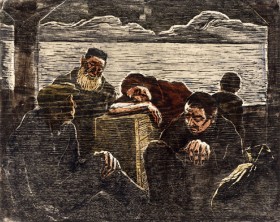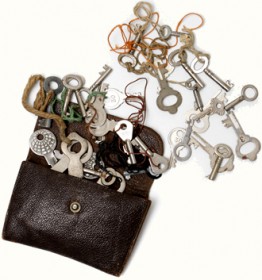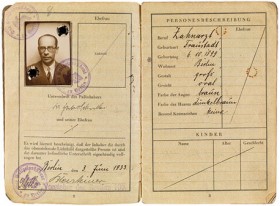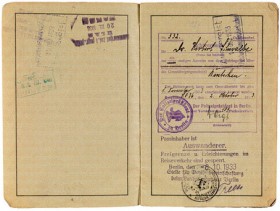An Internet Harvest for the Day of the Refugee

“Refugees”, color woodcut by Jakob Steinhardt, 1946, purchased with funds provided by Stiftung DKLB. You can find this and other related objects in our German-language collection database.
This year’s Day of the Refugee takes place today, 2 October 2015 as part of Intercultural Week, with the slogan “Refugees Welcome!” We have taken this as an occasion to go through our own and other websites and blogs, gathering items on this subject. Since we work at a Jewish museum, stories about fleeing are part of our ‘everyday business’: practically all of the family collections given to our museum tell stories of persecution and flight, going beyond mere statistics to depict the fates of individuals. Letters, travel documents, photographs, and personal memorabilia tell of the desperate search for a country to emigrate to, failed or successful emigrations, the often difficult life in a foreign country, the search for relatives, friends, and former neighbors, now scattered across the entire world. We tell these stories in our permanent exhibition and they have also been the subject of various special exhibitions. At the moment, for instance, in our current cabinet exhibition “In a Foreign Country” you can see publications that originated in Jewish Displaced Persons Camps. Jewish men and women waited there for their passage to Palestine or later Israel, to the USA and other countries, where they hoped to start a new life after the Shoah.
In addition to our exhibitions, we also make stories of flight and displacement visible online, for example with a selection of objects:

Keys to the emigration luggage of the Sommerfeld family, before 1939, leather, metal. Gift of George and Peter Summerfield. Further information about the object on our website.
© Jewish Museum Berlin, photo: Jens Ziehe
these thirty-one keys are all that’s left of the Sommerfeld family’s 1939 emigration luggage. Frieda Neuber’s leather folder with letters from the years 1939 – 1942 tells, by contrast, of a failed emigration. We have made available online as well testimony from our archive that describes the disenfranchisement and exclusion of Jewish citizens in Germany starting in 1933 on our online project “1933. The Beginning of the End of German Jewry.” There you can read the story of Herbert Schwalbe, who emigrated in October 1933 with the intention of reaching Persia. He had received permission to re-establish himself there as a dentist. His passport illustrates an impressive odyssey that ended several years later in the USA, where his family was able to join him. On today’s date, 2 October you will also find from the example of Heinz – later Henri – Aram, that even a name can tell a refugee’s story.
We explain how we handle such documents in our archival workshops with contemporary witnesses. You can also read stories about the Kindertransports of 1938/39 here on our blog and on our website.
From the flight out of Egypt to the flight from the Nazis, the subject of this day is part of Jewish history. But we’re not only interested in Jewish history of persecution along with how Jewish refugees were received in their new countries. Our JMB Journal dedicated its second edition to current questions of migration and integration. The Academy’s programs on migration and diversity regularly put on events that address the question of how mainstream society here must transform over time in order to facilitate the successful coexistence of diverse populations. Going beyond urgent help for newly-arrived refugees and temporary protection like the situation described on our blog about “Kiddush Asylum”, such political transformation is a necessary prerequisite for a ‘Welcome Culture’ of the kind so frequently invoked at the moment. (That culture should by all means be challenged, as demonstrated by a post on the blog “Elalem”.)

Passport issued to Herbert Schwalbe, Berlin, 3 June 1933, pages 2 and 3 with a passport photo and a description of some his features. Gift of Stephanie Wells.
Further information in our online project “1933”.
Pluralist coexistence was also the subject of our book week on literature for children and adolescents. On our blog we introduced a selection of three books that dealt with the topic of fleeing and which we were able expressly to recommend for adults: Janne Teller’s Krieg. Stell dir vor, er wäre hier (“War, What If It Were Here?”), Anne-Laure Bondoux’s A Time of Miracles, and Saša Stanišić’s How the Soldier Repairs the Gramophone. You can find tips for further reading in the German-language brochure put together by the education department, “Multifaceted” (available here as a PDF).
The circumstances and reasons for Jewish flight then and global refugees today don’t allow for an easy parallel. But with historical knowledge about those earlier experiences of escape and the consequences of inadequate destinations to flee to, the current discussion can take place on a more nuanced level.
“One thing that the flight from Nazism in Germany clearly demonstrated is that multiple reasons for leaving often overlap, because anti-Semitic persecution was often paired with economic decline: through employment bans, so-called ‘Aryanization measures’, expropriations, emigration taxes and other measures that made it difficult or altogether impossible for assets to be transferred abroad. […] At present many people are fleeing to Europe to save their own lives. They are fleeing from civil wars, violence on the part of the state or of terrorist groups, from hunger, poverty, and the total lack of prospects. Flight and forced migration aren’t trips. They occur because of existential need and are themselves dangerous. By fleeing, those in flight lose everything they once possessed and risk their lives to do so”,
writes the historian Birke Förster on gefluechtet.de. This online project was called into life by scholars in the humanities and social sciences, in order to “explain from an expert perspective why fleeing happens, how people flee, how the countries on the receiving end deal with them – now and in the past.” The site has collected a wide range of biographies, on people from refugees from East Germany to Roberto Saviano, who lives in hiding from the mafia, in his own country. The site also features aspects of Jewish history, such as the Kindertransports we mentioned above and the story of Felice Schragenheim, whom many know from the film Aimee and Jaguar, and from whom we have some objects in our online collections. Next to the other headings (for biographies, causes, reception, and interrelations, in German), gefluechtet.de offers information about concrete ways to support refugees under the heading, “Was tun?” (what to do).

Passport issued to Herbert Schwalbe, Berlin, 3 June 1933. Pages 6 and 7 with a one-time exit visa valid for the border crossing at Bentschen, issued on 2 October 1933, and an entry on restrictions imposed by the foreign exchange office on 8 October 1933. Gift of Stephanie Wells.
Further information in our online project “1933”.
Personal museum blogs as well as the bloggers of the “German-Jewish blogosphere” (as Juliane Grossmann put it in a talk you can listen to in German on irgendwiejuedisch.com) have also commented on the current situation of refugees. The blogger at “MuseumsGlück” (museum’s luck) explained in a very personal post at the beginning of September why she suddenly became political, supporting the campaign “#BloggerFuerFluechtlinge” (bloggers for refugees). In that post, she challenged German cultural institutions to fulfill their educational mandate in this realm. The “irgendwie jüdische” (‘sorta’ Jewish) blogger Juliane Grossmann is also participating in the campaign #BloggerFuerFluechtlinge and draws the comparison in one blog post between Jewish refugees then and today’s refugees, confessing to the feeling that, “The images are now repeating themselves.” In a post on his blog “Chajm’s View: a Jewish View on Things”, Chajm Guski shows, by quoting the philosopher Moses Maimonides, not only that taking in refugees is ethically proper but also that the help doesn’t end with taking them in, it only begins there. The German-language blog “Fragments from the everyday life of a bibliomaniac mother in Israel” reports on aid campaigns for refugees in Israel, and the liberal rabbi Adrian Michael Schell, formerly of German and now in South Africa, has called for help for the refugees.
In his statement “Prospect and Retrospect on the Cusp of the New Year”, the president of the Central Council of Jews in Germany also spoke shortly about refugees and a ‘welcome culture’:
“We, as a Jewish community, know all too well from history what it means to lose one’s homeland. We stand at the side of the refugees – many congregations ready with direct aid – and we are determined that they will find a safe place of refuge here.” (Josef Schuster in an article in the paper Jüdische Allgemeine)
Recommendations, projects, and aid campaigns have fortunately multiplied since then. We would like at this point to mention the handout on the subject of a welcome culture (available as a PDF) by the organizations Pro Asyl and the Amadeu Antonio Foundation. On this Day of the Refugee we wish a speedy end to the “crisis of bad preparation” (as Anatol Stefanowitsch called it on the radio station Bayern 2) and a long-term welcome culture for the “refuge-seeking” (Sprachlog.de), so that Germany can truly and sustainably become a safe place of refuge.
Mirjam Bitter and Mariette Franz, editors of Blogerim who enjoy the privilege of German passports, would like to do more to help and, for what it’s worth, are now collecting for the initiative “Kreuzberg hilft” (Kreuzberg helps).
Further reading on the subject of flight on our website:
- Website of the exhibition “Home and Exile. Jewish Emigration from Germany since 1933” from 2006/7: http://www.jmberlin.de/exil/en/
- Website of the exhibition “Berlin Transit: Jewish Migrants from Eastern Europe in the 1920s” from 2012: http://www.jmberlin.de/berlin-transit/en/places.php
ENGLISH LINK - Online project “1933. The Beginning of the End of German Jewry”: http://www.jmberlin.de/1933/en/
- Online publication on the cabinet exhibition “In a Foreign Country”, available at: www.jmberlin.de/displaced-persons/en
- Critiques of diversity in children’s and young people’s literature on our blog: http://www.jmberlin.de/blog-en/category/literature/book-week-multifaceted/
- Videos and other material for download, from lectures, conferences, and other events in our Academy programs on migration and diversity in German and English: http://www.jmberlin.de/main/DE/03b-Akademie/04-Akademieprogramme/01-downloads-materialien.php
- Holdings from our collection that have been put online on the subjects of flight, emigration, failed attempts at emigration, preparing to emigrate, and living conditions in exile and emigration: http://objekte.jmberlin.de. Our collection shows a very particular selection, seen historically, because those well-documented efforts to emigrate generally involved people who were able to leave the country early and had both the necessary luggage with them and a mind to preserve their records.